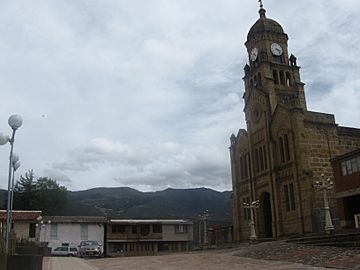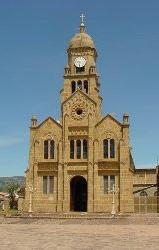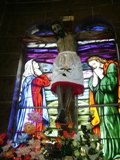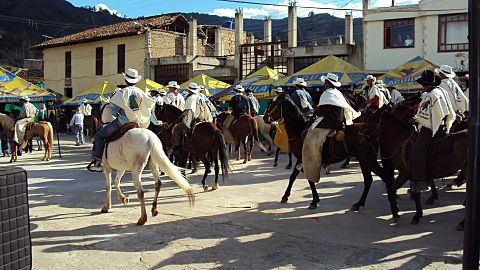Sativasur facts for kids
Quick facts for kids
Sativasur
|
||
|---|---|---|
|
Municipality and town
|
||
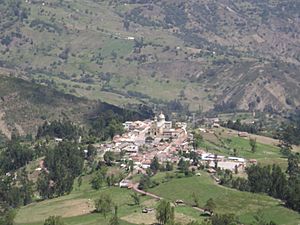
View of Sativasur
|
||
|
||

Location of the municipality and town of Sativasur in the Boyacá Department of Colombia
|
||
| Country | ||
| Department | Boyacá Department | |
| Province | Northern Boyacá Province | |
| Founded | 30 January 1720 | |
| Area | ||
| • Municipality and town | 81 km2 (31 sq mi) | |
| Elevation | 2,600 m (8,500 ft) | |
| Population
(2015)
|
||
| • Municipality and town | 1,110 | |
| • Density | 13.70/km2 (35.5/sq mi) | |
| • Urban | 267 | |
| Time zone | UTC-5 (Colombia Standard Time) | |
| Website | Official website: http://www.sativasur-boyaca.gov.co/index.shtml#1 | |
Sativasur is a small town and a municipality in Colombia. It is located in the Boyacá Department, which is like a state or province in Colombia. Sativasur is about 132 kilometers (around 82 miles) away from Tunja, the capital city of the Boyacá Department.
This town is part of a region called the Northern Boyacá Province. Sativasur shares its borders with other towns. To the north, it borders Sativanorte. To the east, it borders Socotá. To the south and west, it borders Paz de Río.
History of Sativasur
Long ago, even before the Spanish arrived, the area where Sativasur and Sativanorte are now was known as Sátiva. This region was home to the Muisca people, an ancient group who lived in the central highlands of Colombia.
The Muisca had a powerful group of states called the Muisca Confederation. Sátiva was part of the lands ruled by the cacique (which means a local chief or leader) of Tundama, a place now known as Duitama. People lived here during a time called the Herrera Period, which was before the Muisca Confederation.
In 1540, Spanish explorers and soldiers, known as conquistadores, arrived and took control of the area. Some of these leaders were Gonzalo Suárez Rendón and Hernán Pérez de Quesada. Sativasur was officially founded much later, on January 30, 1720.
The names Sativasur and Sativanorte come from the Muisca cacique named Sátiva. In the Chibcha language of the Muisca people, "Sátiva" means "Captain of the Sun."
Economy and Activities
The people of Sativasur mostly earn their living through a few main activities.
- Agriculture: This means farming. People grow crops to sell or use for themselves.
- Livestock Farming: This involves raising animals like cows, sheep, or pigs for meat, milk, or other products.
- Mining: This is the process of digging for valuable minerals or materials from the ground.
These activities are very important for the town's economy and help the community thrive.
Gallery
See also
 In Spanish: Sativasur para niños
In Spanish: Sativasur para niños



